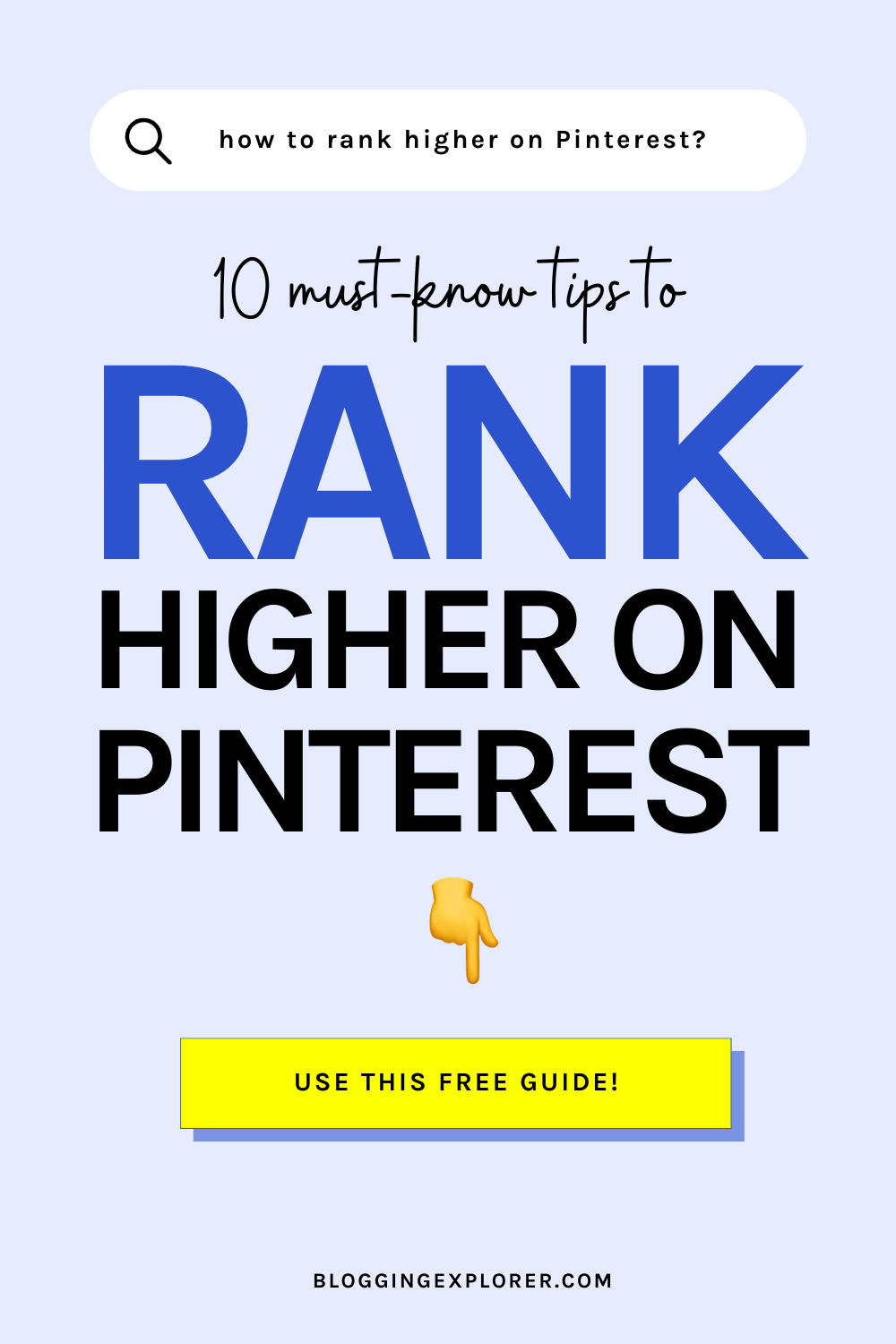If you want to make money blogging, you need to find practical ways to get more visitors to your website. That’s the only way to monetize your content and earn passive income from blogging.
The fastest, most hands-on channel for increasing your blog traffic is Pinterest. It’s free to use and you will see results much faster than from Google SEO.
The best part?
Pinterest allows you to grow your traffic even if you have just started your blog and published your first blog posts.
But where should you start? How can you make sure your content stands out from your competitors on Pinterest?
This guide is a breakdown of my ten most practical tips to learn how to rank higher on Pinterest.
Because Pinterest is a search engine – just like Google – this article will walk you through my proven search engine optimization (SEO) strategies for the platform.
Even if your blog is brand new and it’s not showing up on Google, don’t worry. Pinterest is a faster, more fun channel to generate blog traffic and grow your blog earnings right now.
If you want to see results quickly and avoid repeating the most common Pinterest mistakes I see every day, tag along and let’s jump right in!
Here are a few related articles you should read, too:
- Pinterest Marketing Strategy for Beginners: The Ultimate Guide for Massive Blog Traffic
- What To Do When Your Blog Traffic Is Low? 13 Powerful Traffic Hacks

- 10 tips to rank higher on Pinterest with your blog
- 1. Create a Pinterest business account
- 2. Complete your Pinterest profile
- 3. Find your target audience
- 4. Find your Pinterest keywords
- 5. Set up your first Pinterest boards
- 6. Create valuable, benefit-driven content
- 7. Design stunning, clickable Pinterest graphics
- 8. Follow Pinterest best practices for pinning your content
- 9. Follow a consistent Pinterest marketing strategy
- 10. Use Pinterest Analytics
- Summing it up: How to rank higher on Pinterest to grow blog traffic faster
Please note: This post contains affiliate links to products I use, trust, and recommend. If you choose to purchase a helpful product using these links, I may receive a small commission for referring you – at no extra cost to you. These funds help me keep this blog up and running.
10 tips to rank higher on Pinterest with your blog
How can you get your blog and your blog posts to not only show up on Pinterest, but also rank higher than your competitors?
Here are 10 proven tips you need to know:
1. Create a Pinterest business account
First, if you haven’t already, you need to sign up for a Pinterest business account. This unlocks some powerful features, such as Pinterest Analytics, which will help you track your results and rank higher on Pinterest.
It’s easy to create one and it’s 100% free to use.
Click here to create your business account.
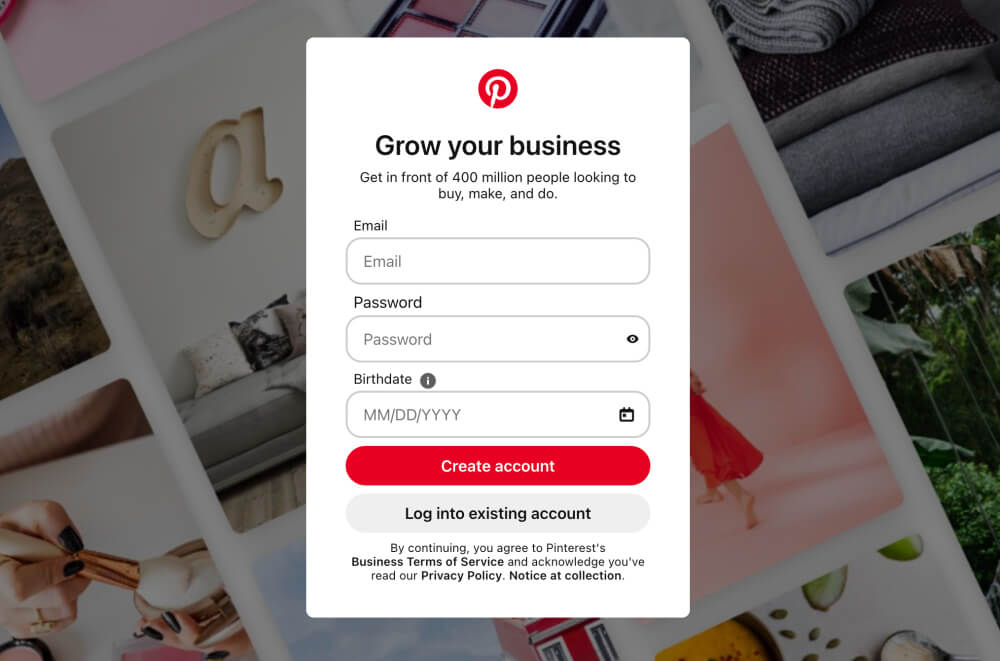
Enter your email address, choose a password, and enter your birthdate.
When you’re finished, click the red button to Create account.
Next, you’ll go through a few steps where you’ll give Pinterest some more details about your blog:
- Pick your language and country
- Add your business name
- Add the website link to your blog:
This is simply your blog’s URL, like bloggingexplorer.com. - Connect your other accounts to Pinterest:
This helps Pinterest attribute pins from your Instagram, Etsy, or YouTube account to you. - Set your advertising preference:
Pinterest wants to know whether you’d be interested in running ads on their platform at some point. - Choose a few topics of interest:
Select one or more topics that best describe your blog or business. - Install the Pinterest browser button:
Choose whether you’d like to add a Pinterest pinning button to your web browser. If you’re not sure, just skip this step. You can always install it later.
Yay, you now have a Pinterest business account!
If you want to convert your existing personal account into a business account instead, head over to https://pinterest.com/business/convert/.
2. Complete your Pinterest profile
When you’ve created your Pinterest business account, it’s time to complete your profile and claim your website.
Claiming your blog website is just a way of verifying that you’re the owner of the URL you entered into your profile.
For all the details, check out my free guide on how to claim your website on Pinterest in 5 minutes.
Next, let’s update your Pinterest profile to help users understand how your content provides value.
Head over to Settings in the upper right corner menu on your Pinterest home screen:
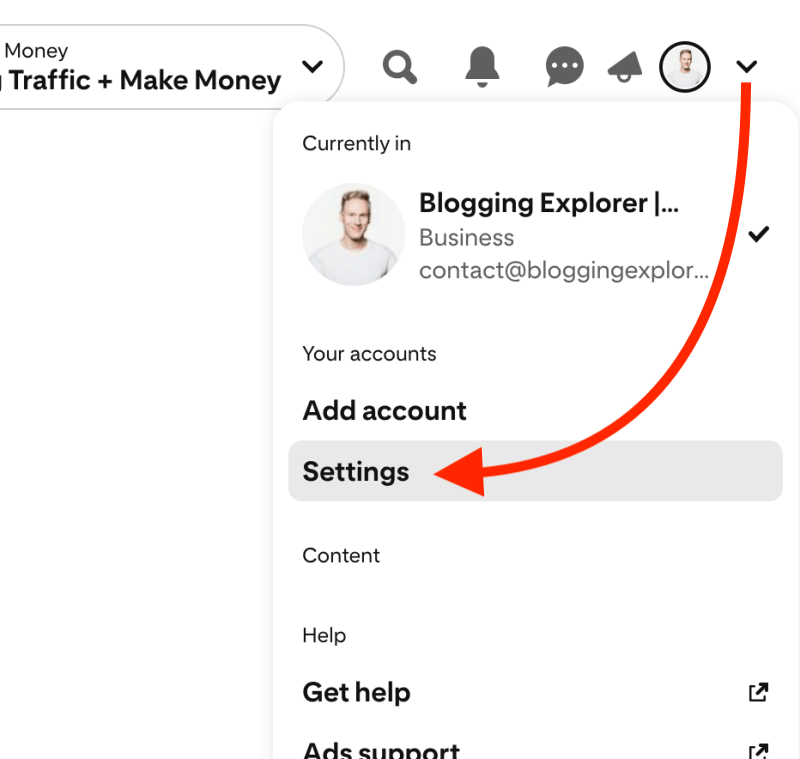
In the settings, head over to Edit profile. Here, you want to:
- Update your profile display name
- Write your About text, which should be a short description of your business
- Make sure your Username reflects your brand name

Your display name and profile description should state very clearly how you help your audience. Use 1-2 relevant keywords if you can, too.
When you are done, remember to save your changes!
3. Find your target audience
If you are serious about ranking higher on Pinterest to increase your blog traffic quickly, you need to know who your target audience is.
Here’s why:
If you don’t know who you’re targeting, you can’t create the type of content your audience truly wants to read.
In other words: when you know your target audience, you will know exactly what they struggle with. That way, you can create the perfect blog posts and answer their biggest questions and solve their biggest problems.
Also, when you publish content that helps your target audience, they will come back to your blog and engage with your Pinterest boards and blog posts. You will generate more followers and more shares, which will help you rank higher on Pinterest.
Finally, knowing what your target audience wants from you means that you can create targeted, tailored digital products to sell through your blog.
Thus, if you want to make money blogging, all you need to do is share your knowledge and your best tips to make your followers’ lives easier. Package your solutions and guides into a digital product and start promoting it on Pinterest.
All in all, knowing your target audience is absolutely crucial for any blogger out there. If you don’t know who they are, you can never create the right kind of content that your ideal readers and followers really need.
If you aren’t sure where to start, check out my free guide on how to find your blog target audience right now.
4. Find your Pinterest keywords
One question I get asked almost daily is:
The answer is: not really.
At first sight, Pinterest has a few social features. People follow each other, comment on pins, and share ideas with each other through private messages.
However, when it comes to how the platform works under the hood, Pinterest is a visual search engine.
When you type a search query in the search bar at the top of the screen and hit Enter, Pinterest shows you the best results for that specific keyphrase.
Here are the search results for “blogging tips”, for instance:
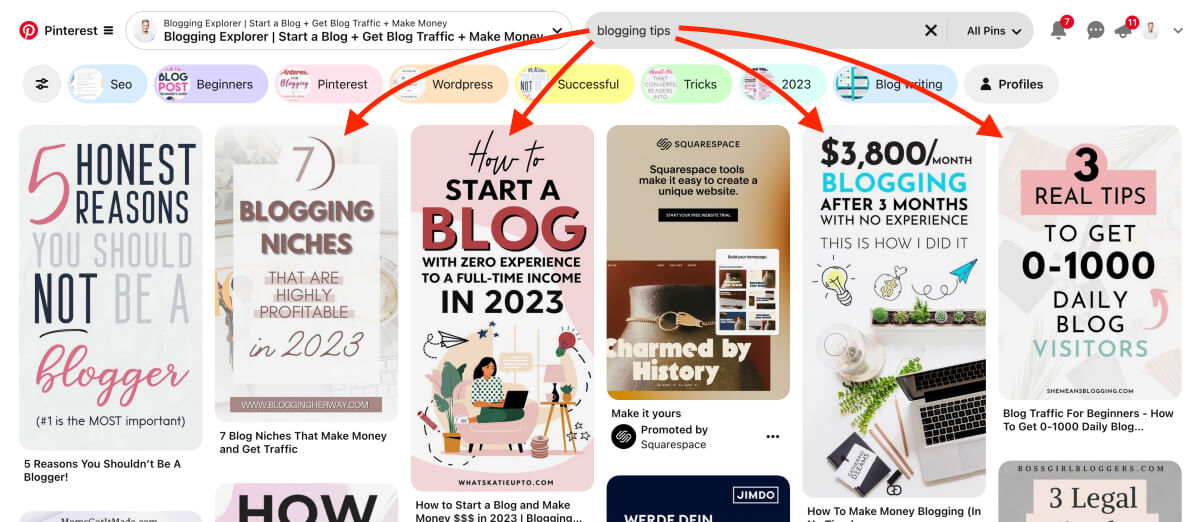
These results are ranked according to how well they match your search query.
Obviously, you want your pins to rank high on Pinterest. That way, more people will see them at the top of their search results, and are more likely to click through to your blog.
So how can you make sure your content ranks among the top results, then?
The only way to “match” your content with a given search query is to use keywords.
Keywords help Pinterest understand what your content is about. In other words: the right keywords help the algorithm show your pin images to people who search for those keywords.
Here are 4 quick keyword tips to rank higher on Pinterest:
- Find your most important keywords:
Use the top search bar to find keyword suggestions. The autofill function is a quick way to find additional keyword ideas. - Track your keywords:
Create a Google Sheet, Trello board, or Coggle mindmap to track and group your keywords. - Focus on long-tail keywords:
Long-tail means that the search phrase consists of several words. Instead of targeting the keyword “gardening”, focus on a long-tail keyword such as “urban gardening tips for families”, for instance. Long-tail keywords are easier to rank higher on Pinterest with, and they generate more clicks than generic, high-level keywords. - Use keywords in the right places:
Once you know what keywords to target, you need to use them across Pinterest in the right places. Use keywords in your pin titles, pin descriptions, board titles, board descriptions, your profile bio, and pin image text overlays.
To become a pro in no time, follow my full guide on how to find and use Pinterest keywords.
5. Set up your first Pinterest boards
Pinterest boards are collections of content that you save on Pinterest.
You will use boards to organize all the pins you save to your profile into logical categories.

To get started with your Pinterest strategy, create at least 5 to 10 boards right now.
Here are a few questions to find ideas for your Pinterest boards:
- What’s your blog niche?
- What types of posts do you write?
- How do you help your readers with your articles?
- What is your target audience looking for on Pinterest?
You can always add more boards easily by opening the Saved tab on your profile. There, click on the plus icon and choose Board:

When naming your boards, you want to use relevant keywords in your niche. This is super important for making sure your content ranks higher on Pinterest and that people can find your pins.
Hence, you must use keywords for your board titles that your target audience is searching for.
For instance, name your chocolate cake recipe board “Chocolate Cake Recipes”. Simple as that, and much better than naming it “Let’s Bake It!”
Although the latter could be cute, it’s not something people actively search for. Using fun names will only hurt your Pinterest strategy and blog traffic.
In short: each board title should indicate what type of content your followers can find on it.
To rank even higher on Pinterest with your content, steal my Pinterest board strategies here.
6. Create valuable, benefit-driven content
Once you’ve completed your profile and created your first Pinterest boards, it’s time to start sharing your content on the platform.
People use Pinterest to find inspiration and new ideas for topics they love spending time with.
We all know Pinterest is great for finding recipes and interior design tips, but you can generate traffic to your website with just about any blog topic you can imagine.
Whatever you blog about, the only thing you should think about is:
How will my content make my readers’ lives easier?
People love discovering easy, quick hacks and tips for solving a specific problem or answering a question they struggle with right now.
Needless to say, you want to deliver the perfect answers and solutions to those problems and questions.
In short: your content needs to be valuable.
The more value, help, answers, tips, tricks, and hacks you provide, the higher you will rank on Pinterest.
So how can you create valuable content, then?
Here are a few of my most popular free guides you want to check out:
- If you haven’t started your blog yet, make sure to follow the best practices in my free guide on how to start a successful blog and make money online.
- For more tips on brainstorming content ideas, don’t miss my 14 quick hacks for finding blog post ideas your readers will love.
- Once you’ve found the perfect content idea, you want to follow my hands-on tips for writing the perfect blog post step-by-step.
7. Design stunning, clickable Pinterest graphics
Since it’s a visual search engine, designing striking graphics is an easy way to rank higher on Pinterest.
Whether you want page views, email signups, or comments from people, getting them to click your pin images is your primary goal. Every click means more free traffic and blog income for you.
Everyone wants to create a viral pin that generates thousands of clicks, right?
Even if you aren’t a designer, it is easy to create beautiful pins with free tools like Canva.

Canva offers a 100% free plan with access to hundreds of plug-and-play Pinterest templates, graphics, stock photos, and more.
I’ve been using Canva since 2016 and I couldn’t be happier with it!
It’s beginner-friendly, fast, and super intuitive to use. If you don’t want to spend money on an Adobe Photoshop subscription, Canva is your best alternative.
Create your free Canva account here.
Here are 4 quick tips for creating beautiful Pinterest images that rank higher:
- Add a text overlay:
Tell your story and catch people’s attention with a benefit-driven text overlay. Why should they read your blog post? - Add a logo:
Place a branding element to give your pins a cohesive touch. Keep it subtle and put it in the middle, either top or bottom. - Use the right size:
Think vertical! The best ratio is 2:3. These vertical images simply perform best and are shared the most by Pinterest. - Use visually compelling images:
Start with free stock photos, for example. Check out Unsplash and Pexels for some great ideas.
For more details, make sure you check out these Pinterest creative best practices.

If you want to supercharge your Pinterest traffic, don’t miss my Canva Pinterest template packs:
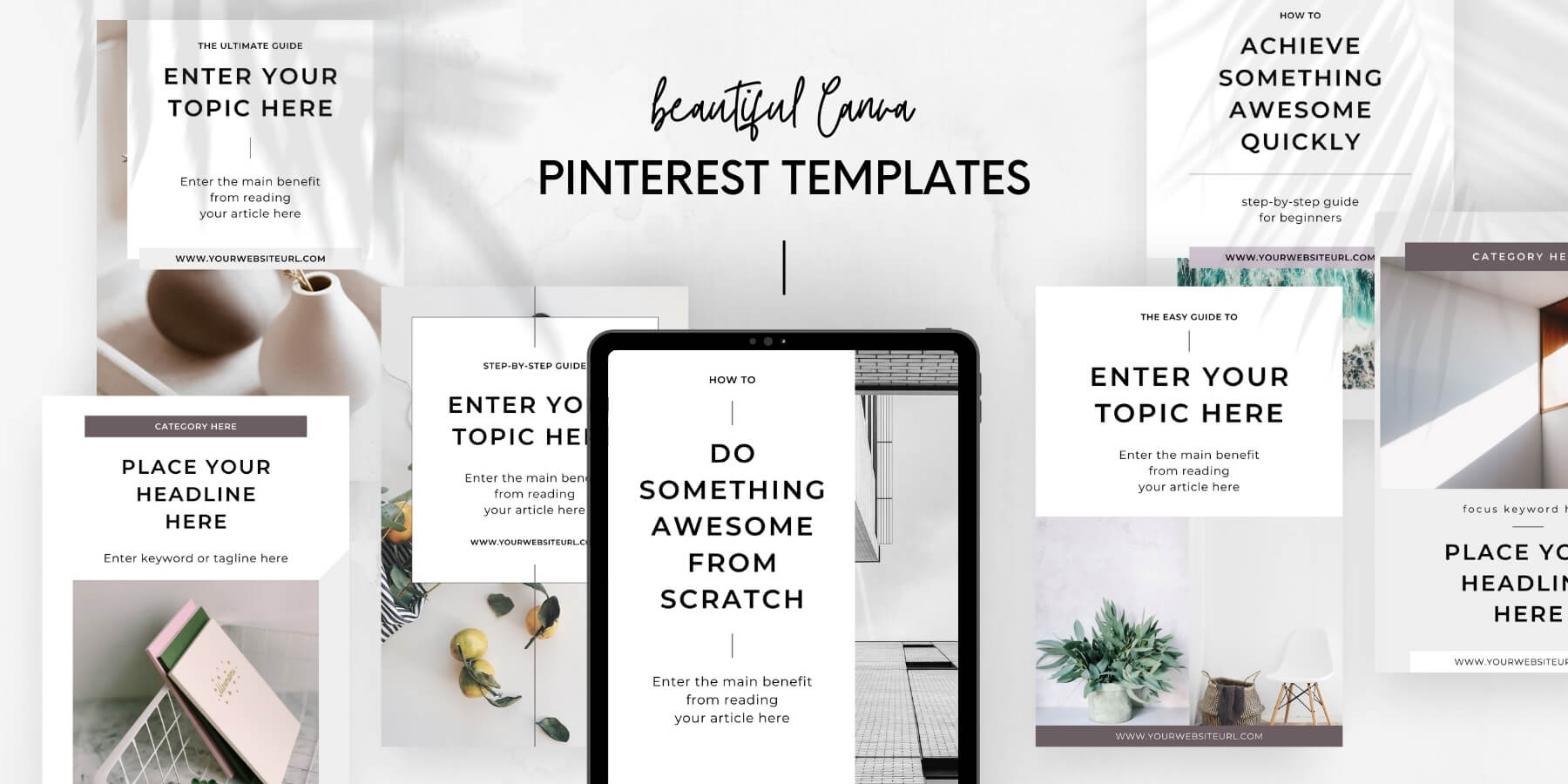
8. Follow Pinterest best practices for pinning your content
Now that you’ve designed a set of magnificent, stunning pin images, it’s time to share them to your Pinterest boards.
But before you start sharing them wildly across all your boards, stop right there.
If you want to rank higher on Pinterest, you need to follow a few best practices whenever publishing new, fresh pin images to your boards.
I know it seems like there are a ton of rules to follow on Pinterest. It can sometimes feel overwhelming to keep track of all the tactics and strategies I’m covering in this guide.
Just take it slow and learn one thing at a time. It’s perfectly OK to take your time to practice and get comfortable with Pinterest.
To make sure your content ranks high on Pinterest, follow these best practices when sharing pins to your boards:
- Pin your own content:
Pinterest loves new, fresh pins even for older blog posts. Stay consistent and create 5 to 10 new pins weekly. Save other people’s pins to your boards if you don’t have a ton of your own pins created just yet. - Save viral pins from other creators to your boards:
You should always focus on creating as many new, fresh pins for your own content. But saving 3rd party pins (pins from other accounts) can boost your own pins’ performance, too. When a given board includes a combination of viral 3rd party pins and your own pins, the Pinterest algorithm makes connections between them — but only as long as they are related, both visually and content-wise. As a result, the algorithm will start showing your pins in more places, like the “More like this” recommendations underneath those viral pins. - Create multiple pins for each blog post:
You don’t have to publish a new blog post every day to create a new, fresh pin image. It’s perfectly OK to create new pin images for your old blog posts, too. This helps you figure out what types of designs resonate with your audience. - Only save relevant content to each board:
The pins you save to a board must match the board title and description. Never save pins to a board that don’t match the overall topic of that board. - Save each pin to the most relevant board first:
If a pin image is a good fit for multiple boards on your Pinterest profile, save it to the most relevant one first. This helps the Pinterest algorithm understand what that pin is about and which users would be interested in seeing it. - Pin the same content to other relevant boards at intervals:
When you create a new pin, don’t post it to a dozen boards on the same day. That’s going to look spammy to both Pinterest as well as your followers. Give the algorithm at least 2 to 3 weeks to figure out how that pin is performing before you save it to the next most relevant board. Keep following the same interval between each round of re-pinning. Tailwind is a free scheduling tool that makes this super easy. - Share new blog posts to Pinterest right away:
Whenever you publish a new blog post, share it to the most relevant Pinterest board asap.

9. Follow a consistent Pinterest marketing strategy
To rank higher on Pinterest for months and years to come, you should set up a Pinterest marketing strategy asap.
More importantly, once set up, you have to follow your strategy and stay consistent.
Why?
Because the Pinterest ranking algorithm loves content creators who stay active on the platform. If you take breaks from pinning and sharing your content on Pinterest, your rankings and blog traffic will decline.
So how can you come up with a surefire Pinterest marketing strategy to follow?
Here are 5 quick tips for a successful Pinterest marketing strategy:
- Be realistic:
The more new, fresh pin images you share, the better. But don’t overwhelm yourself with too much ambition. Start small and share 5 new pins every week, for example. See how it goes and adjust the number if needed. - Share new content right away:
Whenever you publish a new blog post, share it on Pinterest right away. Create a beautiful pin with Canva and add it to your blog post. Once published, save your pin image to the most relevant board on your Pinterest profile. - Share other people’s content:
When creating new boards on Pinterest, save at least 15-20 relevant, high-quality pins from other people’s profiles to each new board. This helps the Pinterest algorithm understand what your Pinterest boards are about. Keep saving third-party pins to your boards regularly to fill out your pinning schedule. - Create your own pin templates:
Designing beautiful Pinterest graphics takes a lot of time. Speed up your work by creating 2-5 pin templates in Canva, for example. Each template should have a slightly different design. When you publish a new blog post, you can simply adjust the text overlay, set a new background, and tweak the design slightly if needed. And boom – you’ve just created up to 5 fresh pins in a matter of minutes. - Follow your keyword strategy:
Keywords are absolutely crucial. The best and only way to rank higher on Pinterest is to use the right Pinterest keywords in your pins, boards, profile description, and blog posts.
How’s your Pinterest marketing strategy going to look like? Share your thoughts in the comments below!
10. Use Pinterest Analytics
If you really want to rank higher on Pinterest, you need to monitor your results so you’ll know what’s working and what isn’t.
After all, you don’t want to follow a strategy without actually knowing it’s bringing you the results you want.
The easiest way to know what tactics are working for you is to use Pinterest Analytics.
In your Analytics dashboard, you will see a breakdown of how your boards, pins, and content are performing.

You can quickly find your top-performing boards, for example. Focus your efforts on creating additional, valuable content for these boards!
If a certain board is already attracting a ton of views and clicks, you should boost its performance by keeping it active.

Also, keep an eye on your top pins. Use the overview of your most successful pins to:
- Figure out what type of pins are performing the best (traditional pins, idea pins, etc.)
- See what designs perform the best (images, text overlays, backgrounds etc.)
- Find out what color palettes resonate the best with your audience
- Define your most popular pin topics and posts (create new, fresh pin images for your top-performing blog posts)
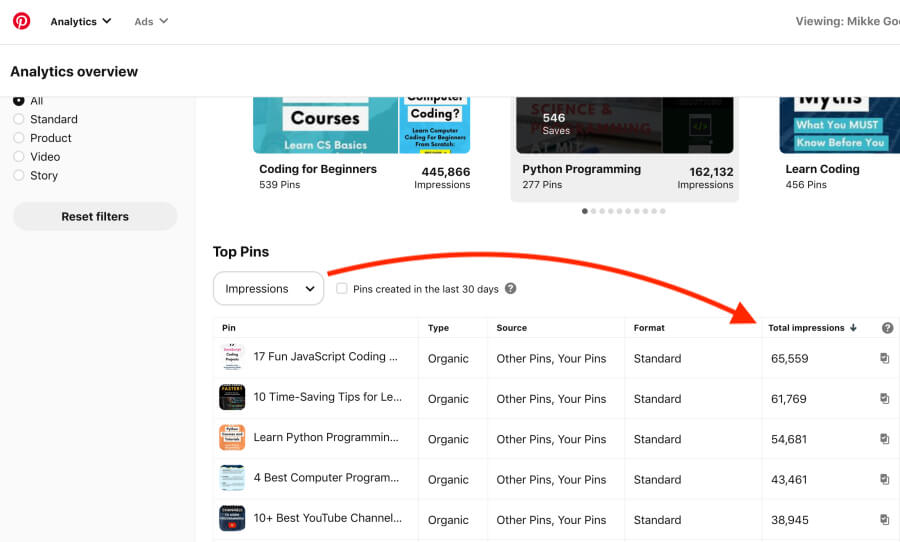
Even if you are new to Pinterest, start experimenting with the different tools in Pinterest Analytics asap.
I know the interface can look overwhelming when you open it for the first time. Start slow and learn one feature at a time.
For example, start by looking at your best boards. Pay attention to which boards attract the most views, engagements and outbound clicks to your blog. Focus on those boards going forward!
Creating fresh pin images for those boards helps you rank higher on Pinterest in the long run for years to come.
Summing it up: How to rank higher on Pinterest to grow blog traffic faster
Simply signing up on Pinterest and posting beautiful images to your boards isn’t enough, especially if you want to make money blogging.
You need your pins and boards to rank higher on Pinterest for the most important keywords in your niche.
The good news is:
Although Pinterest is a search engine, you can see results from the best practices we covered in this guide much faster than on Google.
I’m not saying that you should neglect Google SEO completely, though. Start learning search engine optimization as soon as possible. Although it may take time to see results, your SEO traffic will ramp up with time.
Your next step is to learn more about Pinterest SEO. Invest your time wisely in creating value-driven, helpful content that makes your readers’ lives easier. The more value you deliver, the easier it is to rank higher on Pinterest (faster).
Of course, Pinterest and Google shouldn’t be your only sources for blog traffic. Take a look at other proven ways to promote your blog, too. They will help you grow your email list, increase your online visibility, and generate more blog income.
It takes hard work to see the best possible results on Pinterest. But if you know what you’re doing, you can simply work your way through the necessary steps one by one.
Therefore, make sure you complete each step in this guide before moving on to the next one. They build on top of each other, so take your time and don’t skip ahead.
